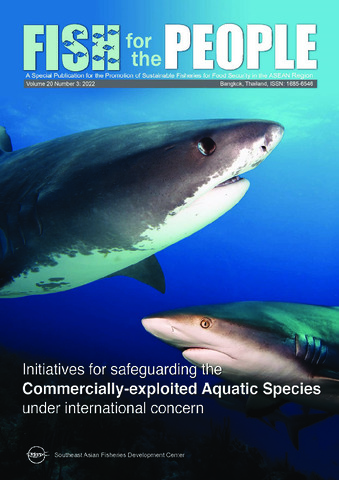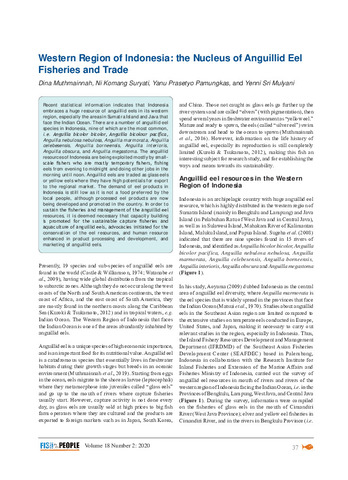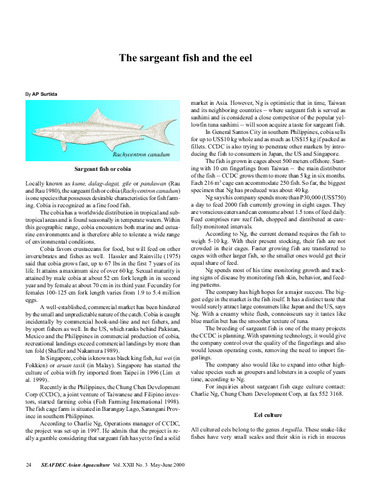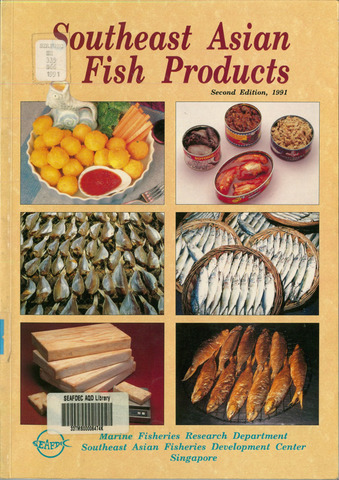Fish for the People Vol.20 No.3

ရက်စွဲ
2023-02Page views
1,751
Share
စိတ္တဇ
Aquatic species are exploited for food security and livelihood but some of them could be fully exploited or overexploited if not properly managed. The ASEAN Member States (AMSs), i.e. Indonesia, Philippines, Thailand, and Viet Nam, are among the top producers of fish and fishery products that are supplied to the international markets including the United States, Europe, China, Japan, and others. One of the global initiatives to ensure that international trade in wild animals and plants does not threaten the survival of the species is the establishment of the Convention on International Trade in Endangered Species of Wild Fauna and Flora (CITES) in 1975 as an international agreement between governments. During the past decade, several commercially-exploited aquatic species (CEAS) had been proposed and listed in the Appendices of CITES. However, the proposals for inclusion of species into the CITES Appendices have to be considered and decided by votes by the CITES Parties. Therefore, the Food and Agriculture Organization of the United Nations (FAO) is actively assessing the proposals for listing CEAS in the CITES Appendices from a scientific perspective and in accordance with CITES biological listing criteria; while the Southeast Asian Fisheries Development Center (SEAFDEC) is providing fora for the Member Countries to share information, build up relevant technical capacity, and develop common/coordinated positions in response to the proposals.
In the region, there are several CEAS that are subject to CITES as well as other conservation and management measures, such as sharks and rays, seahorses, anguillid eels, among others. This issue of “Fish for the People” features the international concern relevant to CEAS, including the roles of FAO and SEAFDEC in gathering data and information to obtain a better knowledge of the status and trends of some of these species, and ensuring conservation and management for sustainable utilization. However, there is also a need to recognize that the Southeast Asian region fisheries are characterized by a large number of small-scale fishers using multigear and harvesting multispecies of aquatic organisms.
Sharks and rays are commercially important species in the region but they are not targeted for most fisheries and are usually bycatch. However, this resource could result in overexploitation if fishing activities are not properly managed. The activities were led by SEAFDEC Marine Fishery Resources Development and Management Department (MFRDMD) to obtain sufficient information including the collection of data on landings, trade, and nursery grounds; identification of species through DNA analysis; development of human resources; raising public awareness; among others. Such information is also necessary to support the development of non-detrimental findings (NDFs) that are crucial for the countries to export the species listed in CITES Appendix II. In commitment to the International Plan of Action for Conservation and Management of Sharks (IPOA-Sharks), several Southeast Asian countries have adopted their respective NPOA-Sharks that outline the measures to ensure that the species are properly managed toward sustainable utilization.
The United States is the topmost country in the world importing aquatic products, and marine mammals are among the species groups under their concern. In order to protect marine mammals, the US Marine Mammal Protection Act (MMPA) was decreed which prohibits importations of commercial fish or fishery products from commercial fishing operations resulting in incidental killing or serious injury (bycatch) of marine mammals. Considering that the implementation of MMPA could impact the region’s fisheries sector, SEAFDEC in 2021 started providing a forum for the AMSs to discuss the major issues and challenges in complying with the MMPA.
For tropical anguillid eels, the species are catadromous making them vulnerable to fishing activities, especially considering the high price and market demand. Several AMSs developed their respective national fishery management programs and regulations to carry out effective management practices for the sustainable use and conservation of tropical anguillid eel resources. The Inland Fishery Resources Development and Management Department (IFRDMD) of SEAFDEC supported the AMSs by conducting activities on data collection, biodiversity monitoring, stock enhancement, and involvement of stakeholders. Furthermore, the SEAFDEC Aquaculture Department also conducted a study of the performance and feed utilization of high-value eel species in cage conditions, the results of which are relevant information to the aquaculture development of tropical anguillid eels.
ဘာသာရပ်
aquatic animals  ; shark fisheries; cartilaginous fishes
; shark fisheries; cartilaginous fishes  ; landing statistics
; landing statistics  ; marketing
; marketing  ; trade
; trade  ; nursery grounds
; nursery grounds  ; DNA barcoding
; DNA barcoding  ; marine mammals
; marine mammals  ; capture fishery economics
; capture fishery economics  ; fish products
; fish products  ; fishery products
; fishery products  ; fisheries law
; fisheries law  ; eel culture
; eel culture  ; fishery policies
; fishery policies  ; fishery regulations
; fishery regulations  ; catch statistics
; catch statistics  ; aquaculture
; aquaculture  ; growth
; growth  ; cage culture
; cage culture  ; feed conversion efficiency
; feed conversion efficiency  ; inland fisheries
; inland fisheries  ; inland waters
; inland waters  ; small-scale fisheries
; small-scale fisheries  ; fishery management
; fishery management  ; community involvement
; community involvement  ; rays (fish)
; rays (fish)  ; imports
; imports  ; fishery production
; fishery production  ; fish processing
; fish processing  ; Southeast Asia
; Southeast Asia  ; United States
; United States  ; Philippines
; Philippines  ; Indonesia
; Indonesia 
 ; shark fisheries; cartilaginous fishes
; shark fisheries; cartilaginous fishes  ; landing statistics
; landing statistics  ; marketing
; marketing  ; trade
; trade  ; nursery grounds
; nursery grounds  ; DNA barcoding
; DNA barcoding  ; marine mammals
; marine mammals  ; capture fishery economics
; capture fishery economics  ; fish products
; fish products  ; fishery products
; fishery products  ; fisheries law
; fisheries law  ; eel culture
; eel culture  ; fishery policies
; fishery policies  ; fishery regulations
; fishery regulations  ; catch statistics
; catch statistics  ; aquaculture
; aquaculture  ; growth
; growth  ; cage culture
; cage culture  ; feed conversion efficiency
; feed conversion efficiency  ; inland fisheries
; inland fisheries  ; inland waters
; inland waters  ; small-scale fisheries
; small-scale fisheries  ; fishery management
; fishery management  ; community involvement
; community involvement  ; rays (fish)
; rays (fish)  ; imports
; imports  ; fishery production
; fishery production  ; fish processing
; fish processing  ; Southeast Asia
; Southeast Asia  ; United States
; United States  ; Philippines
; Philippines  ; Indonesia
; Indonesia 
Taxonomic term
စုစည်းမှုများ စုစည်းမှုများ
Related items
Showing items related by title, author, creator and subject.
-
Western Region of Indonesia: the Nucleus of Anguillid Eel Fisheries and Trade
Muthmainnah, Dina; Suryati, Ni Komang; Pamungkas, Yanu Prasetyo; Mulyani, Yenni Sri (Secretariat, Southeast Asian Fisheries Development Center, 2020)Recent statistical information indicates that Indonesia embraces a huge resource of anguillid eels in its western region, especially the areas in Sumatra Island and Java that face the Indian Ocean. There are a number of ... -
The sargeant fish and the eel
Surtida, Augusto P. (Aquaculture Department, Southeast Asian Fisheries Development Center, 2000)The culture of sargeant fish, or cobia (Rachycentron canadum) and eel (Anguilla spp) in the Philippines is discussed. Market potentials for the cultured products are examined. -
Southeast Asian fish products
Ng, Mui Chng; Hooi, Kok Kuang; Miwa, Katsutoshi (Marine Fisheries Research Department, Southeast Asian Fisheries Development Center, 1991)This report is a comprehensive record of fish products in the region, and will be of interest to researchers, food scientists, fish technologists and administrators. It will also be useful for fish traders, and may be used ...




